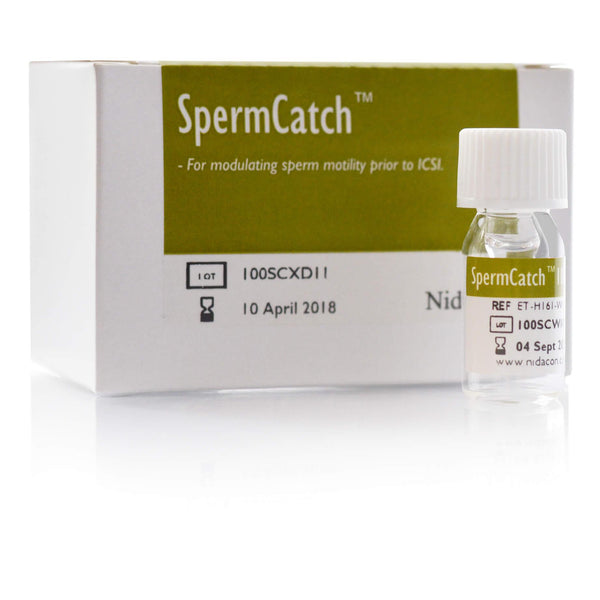SpermCatch
Hyaluronic Acid based natural alternative to polyvinyl plastic (PVP) for slowing sperm for ICSI.
SpermCatch is a natural alternative to polyvinylpirrolidone (polyvinyl plastic – PVP) for slowing sperm for ICSI. Clinicians have always been concerned that injecting this artificial product (PVP) into the oocyte along with the sperm may cause damage to acrosomal, mitochondrial and plasma membranes, as well as to the chromosomal DNA.
Features
- An alternative method for modulating sperm motility based on Hyaluronic Acid.
- 1 year shelf-life
- SpermCatch contains only substances normally found in the mammalian reproductive tract. Exposure of sperm to SpermCatch, not only slows sperm, but also mimics the naturally occurring sequence of events during in vivo fertilization.
Components
- Sodium chloride
- Potassium chloride
- Magnesium sulphate
- Potassium dihydrogen phosphate
- Sodium bicarbonate
- hSA (human Serum Albumin)
- Purified water
- Glucose
- Calcium lactate
- Sodium pyruvate
- EDTA
- HEPES
- Hyaluronic Acid
Performance Characteristics
- pH: 7.0 – 8.5.
- Osmolality (mOsm/kg H2O): 290-320.
- Endotoxin levels: <1.0 EU/mL.
- Sperm survival after preparation and after 18 hours in SpermCatch: > 50%.
- Contents are tested by human sperm survival only.
- Bottles and screw caps are M.E.A. tested.
Protein Supplement
SpermCatch contains the component human serum albumin. (hSA). The human serum albumin is manufactured from human blood donated in the United States. The blood donors who supply the human plasma are tested for various viruses before being allowed to donate blood for this purpose. Each plasma donation is individually tested for ALT, HBs antigen, HIV-1/2 antibody and HCV antibody by ELISA. Only those plasma donations found non-reactive for those antibodies have been used for the manufacture of the hSA component. The plasma pool is tested again before manufacture of the hSA product. The hSA product is heated at 60ºC for 10 hours as a final precaution.
Storage and Stability
- Store unopened bottles at 2 to 30ºC and avoid temperatures above or below these values. Under these conditions SpermCatch has a shelf-life of 12 months. The expiry date is shown on both bottles and cartons.
- Open and close bottles under aseptic conditions. After opening, store at 2 to 8ºC when not in use. Shelf-life on the product label applies when the product is stored according to manufacturer’s recommendations.
- No antibiotics, unstable additives or preservatives have been added by the manufacturer to SpermCatch.
Precautions and Warnings
- Use aseptic procedures at all times.
- SpermCatch does not represent any fire or combustion hazard. A material safety data sheet is available from the distributor or manufacturer.
- Do not use any solution which shows evidence of bacterial contamination.
- Do not use contents if tamper-evident seal is broken.
- Federal Law (USA) restricts this device to sale by or on the order of a physician.
- Please check for regulatory compliance governing the use of ART products in your country.
Documents
SDS – View PDF
Product insert (latest version) – View PDF
Leaflet – View PDF
Specifications:
| Mfr. No. SC-100 | SpermCatch / 6 × 100 µl (Not available in Europe) |
References
Intracytoplasmic morphologically selected sperm injection (IMSI) after repeated IVF or ICSI failures: a prospective comparative study
Delaroche L1, Yazbeck C, Gout C, Kahn V, Oger P, Rougier N.
Eur J Obstet Gynecol Reprod Biol. 2013 Mar;167(1):76-80
Effects of polyvilylpyrrolidone on sperm function and early embryonic development following intracytoplasmic sperm injection in human assisted reproduction
Yoku Kato, Yoshikazu Nagao
Reprod Med Biol. 2012 Apr;11:165-176.
An alternative to PVP for slowing sperm prior to ICSI.
Balaban B, Lundin K et al
Hum Reprod. 2003 Sep;18(9):1887-9.
Detrimental effects of polyvinylpyrrolidone on the ultrastructure of spermatozoa
Strehler E, Baccetti B, Sterzik K, Capitani S, Collodel G, De Santo M, Gambera L, Piomboni P.
Hum Reprod. 1998 Jan;13(1):120-3.
Hyaluronic acid binding by human sperm indicates cellular maturity, viability, and unreacted acrosomal status.
Huszar G, Ozenci CC, Cayli S, Zavaczki Z, Hansch E, Vigue L.
Fertil Steril. 2003 Jun;79 Suppl 3:1616-24.


